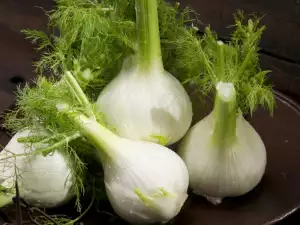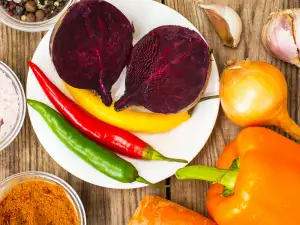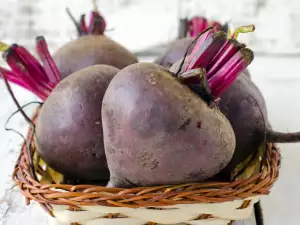Beetroot (Beta vulgaris ssp. vulgaris var. vulgaris) is a species of root vegetable. One of its varieties is the beetroot, which can be recognized by its dark red roots, which stain quite a bit when cut. The taste of beetroot is specific, earthy, refreshing.
Beetroot are eaten boiled, roasted beetroot is also very tasty and raw. All parts of it are edible and the beetroot leaves can be eaten in a salad. Their taste resembles that of spinach. Dye can be extracted from beets. Since ancient times they have been used in folk medicine as an herb for the treatment of various diseases.
As far back as the ancient Greeks and Romans, beets were used to reduce high fever. During the Middle Ages in Europe, beetroot juice was given to people who for one reason or another could not consume solid food. The Romans were even firmly convinced that if a man and a woman ate from the same beet, they would fall in love.
Beetroot is an important ingredient of a complete seasonal diet. It is a must food for active athletes who want to continuously improve their sports performance and have greater endurance. This is due to the nitrates that beetroot contains. These compounds spare the body's oxygen reserves and provide energy.
Composition of beets

Beetroot contains an average of 88% water, 1.2% proteins, 9.3% carbohydrates, 0.9% mineral salts, including potassium, calcium, phosphorus, iron, sulfur, iodine, cobalt, molybdenum, manganese, fluorine, boron, vanadium, iodine , cesium and rubidium. In terms of iodine content, beets are the leader among vegetables. This makes it widely used for the prevention and treatment of hypothyroidism, a thyroid disease caused by iodine deficiency.
Beets contain small amounts of vitamin C, carotene, vitamins B1, B2 and B12. Thanks to the presence of potassium salts, sulfur, phosphorus and magnesium, the metabolic processes in the body are accelerated.
The red color of beetroot is due to the coloring substances, from the group of anthocyanins. In addition to all this, beetroot is highly valued as an excellent dietary product, because 100 g of the root vegetable contains only 44 calories.
100 g of beets also contain about: 87 g of water, 1.7 g of proteins, 0.1 g of fat, about 1 g of cellulose and about 9.5 g of sugars and carbohydrates.
Selection and storage of red beets

Beets are sold year-round in markets and supermarket chains. Choose root vegetables without damaged areas, large and heavy, preferably with a shorter root. The skin should be rich in color and the inside should be blood purple-red. When choosing it, it is important to choose only those that have a dense structure, a dark red color and no white spots. It is believed that those that have a cylindrical shape have the greatest benefit for the body. When cut, beetroot stains quite a bit, so protect your clothes.
To store beetroot for several months, you need to take good care of it and sort it. Remove damaged beetroot heads - bruised or rotten. In no case should you wash the heads, because this way you create a prerequisite for them to start rotting. With a sharp knife, cut the leaves off each head, so that they don't suck the moisture out of the beetroot.
Leave all beetroot heads in a well-ventilated area to dry. While the beets dry, they should not be exposed to direct sunlight. You can only keep beetroot fresh if you keep them in a cool place.
Culinary use of beets

The popularity of beets as a complete, healthy and medicinal food has increased. If you ask your grandmother, she will probably well remember that beets were once used to feed the animals in the village.
Today, its application in cooking is constantly expanding. The most popular are beetroot salads, in combination with cabbage, carrots, potatoes, apples, pickles and what not.
Pork roast will have an unique taste if you add slices of beetroot under the foil. Quite tasty sauces are also prepared from it. Anything you add beetroot to will turn a deep blood to purple color. Of course, the popular Borscht cannot go without the addition of beetroot.
A large part of the commercial production is processed in boiled and sterilized form. Beetroot leaves are also edible. They can be cooked, steamed or eaten fresh in salads, with a taste similar to spinach leaves.
See more beetroot culinary tricks.
Beetroot and cream salad
Necessary products: 300 g of beets, 200 g of apples, 120 g of cream, 1 tbsp. of grated horseradish, lemon juice.
Method of preparation: Boil the beets in salted water and with 1 tsp. of vinegar or just roast it. Cut it into cubes and add the chopped small or grated apples. Mix with the cream, beaten with horseradish, salt and lemon juice. If desired, add parsnips or carrots instead of horseradish and yogurt instead of cream.
Benefits of beetroot

It has been categorically established that regular consumers of beets take preventive care against the occurrence of cancers. Cases of skin cancer have even been recorded, in which the application of beet juice compresses several times a day led to the complete disappearance of the malignant formations.
Like the Romans, even today, specialists recommend beetroot for chronic constipation, various disturbances in the digestive system and liver diseases. For this purpose, 100-150 g of raw beetroot, preferably boiled, are sufficient.
Chinese medicine has long known that beetroot strengthens the heart, balances the body and purifies the blood. Beetroot juice is quite recommended for women who are in menopause. Beetroot juice stimulates the liver, kidneys, gall bladder, spleen and intestines and provides an overall strengthening of the immune system, especially when fighting colds.
In folk medicine with beets they also treat patients with leukemia and because of the chlorophyll it contains, it is an indispensable ingredient in the menu of those suffering from anemia.
The paradoxical fact is that, despite the presence of sugars, beets are healthy for consumption even by diabetics. It supports the absorption of nutrients and accelerates the elimination of toxins from the body. It contains good levels of iodine and magnesium, making it a suitable food for the elderly and those suffering from atherosclerosis.
Be sure to consume beetroot regularly, especially during the winter months. The cocktail of beetroot juice, apples and squeezed lemons is a vitamin bomb. It can protect you from the flu and as already mentioned - it purifies the blood and slows down the aging process.
In fact, the cellulose, malic, citric and other acids contained in the beets are the ones that enhance peristalsis, assist in the breakdown and absorption of proteins and increase the vital activity of the liver.
About 200-300 ml of beetroot juice per day improves the general condition of the body. This elixir, mixed with equal parts of carrot and turnip juice, helps with anemia.
If you mix it with honey, beetroot juice is used for high blood pressure and as a sedative. 1 cup of beetroot juice per day will improve your memory and ability to remember disparate and disorganized information by 50%. Mashed beetroot is a proven aid for wounds and swelling.
Beetroot juice is extremely healthy if no contraindications are observed. It is good to make it in combination with pumpkin juice, for example and also leave it for about 1-2 hours. Then drink a little at a time for about 5-10 minutes. This way, the benefit of it for the body will be maximum. It should not be taken immediately after it has been squeezed, as side effects such as nausea and headache are often observed.
Contraindications when consuming beets

Like any product, beetroot has its contraindications for use in certain health conditions.
- diseases of the gastrointestinal tract in an acute stage;
- gastritis with high acidity;
- hypotension;
- tendency to diarrhea;
- the second stage of urolithiasis;
- individual intolerance.
To test whether beetroot works well for you, it is good to start adding it to your diet gradually with about 5-10 grams per day or 1-2 teaspoons. For example, you can add boiled beets to your salad, which will add a new flavor to your culinary creation. Along with this, it is important to monitor the presence of any side effects - nausea, headache, rash, diarrhea. If these are not observed, then the daily rate can be gradually increased to 200 grams.
Experts advise combining the intake of raw beetroot with fresh cucumbers or carrots, which soften the active effect of the vegetable.
It is important to note that beetroot is a natural laxative. The root vegetable should not be taken in large quantities, because it can cause spasm of the blood vessels. It should not be consumed by people who suffer from increased stomach acidity, as this vegetable will increase it even more.
Beetroot is contraindicated for use in case of increased excretion of oxalic acid. It is also forbidden for consumption and especially the juice of the vegetable, if you have oxaluria (increased urinary calcium oxalate in the urine). Do not forget that this root vegetable is rich in sugars, so it is contraindicated for people who have been diagnosed with diabetes, as it raises blood sugar.
Beetroot diet

Beetroot is low in calories and suitable for weight loss diets. The beetroot diet, in addition to helping you lose weight, will restore your body after exhaustion. It also helps with hair growth and strengthening.
By following a beetroot diet will, among other things, make your skin glow. In combination with exercise during the diet, you can successfully fight against cellulite.
The beetroot diet dictates that you drink 1 cup of freshly squeezed beetroot juice in the morning on an empty stomach. The second consumption is in the evening and before 8:30 p.m. you should eat a salad made of cabbage, beetroot and carrots, seasoned with olive oil.
Also read how to grow beetroot or try our beetroot recipes.



















Comments